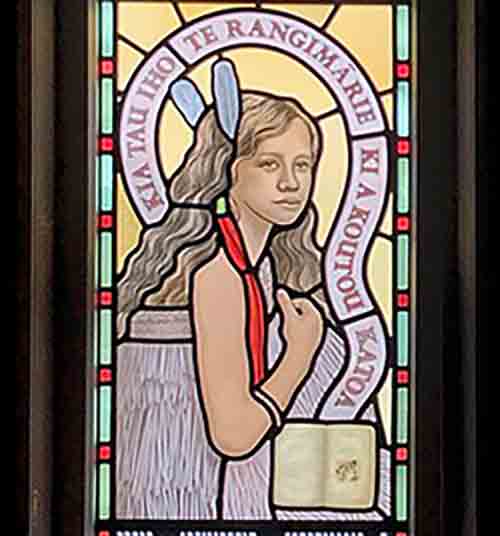
E te Matua i te Rangi i karangatia matou kia rite ki te tamariki nohinohi i te mea no te penei te rangatiratanga o te Rangi. Ka whakawhetai matou mo Tarore i kawe nei i te Rongopai a Ruka. Hanga ki roto ki a matou i tau whanau hoki he aroha kia pono kia hohonu kia noho tahi ai matou i roto i te aroha me au tamariki katoa, i roto i te kotahitanga o te Wairua Tapu, ko te Karaiti hoki te Hepara pai. Amine.
Gracious and loving God,
we thank you for Tarore,
whose death brought not vengeance but reconciliation;
create in us, your whanau,
a gospel love and a truth so deep,
that we too may live together in love with all your children,
in the unity of the Holy Spirit;
through Jesus Christ our Redeemer.
Today we commemorate Tarore of Waharoa, who lived 1824 to 18 October 1836. Her father was Ngakuku, a chief of the Ngati Haua of Tainui. Tarore was taught to read from the age of ten by Charlotte Brown of the Church Missionary Society at a mission school. In 1836 she was given a copy of the te reo Māori Gospel of Luke published earlier that year. Her commemoration following the day after St Luke’s Day is highly appropriate.
She was considered a prodigy because of her ability to memorise much of this Gospel book. She would recite portions of the Gospel to crowds of 200–300 of her people and was supported by her father who was a lay evangelist.
Because of conflict between iwi (tribes), in October 1836, Tarore was evacuated with the other pupils from her school in Matamata. She had her Gospel of Luke in a small kete (basket) around her neck. On the night of 18 October, this group was attacked by a Ngāti Whakaue war party from Rotorua. Tārore was murdered and Luke’s Gospel was taken by Paora Te Uita.
At her tangi (funeral) her father spoke words of forgiveness and said, “do not rise up to obtain satisfaction for her. God will do that.”
Paora Te Uita learnt about Ihu Karaiti (Jesus Christ) from Tarore’s Gospel of Luke. He sought forgiveness from Ngākuku. This helped to spread the Good News in Aotearoa New Zealand.
Information sourced here and here.
image source: Tarore stained glass window, designed by Suzanne Johnson of Glassworks in Mt Eden, Auckland in 2011. Three fantails at the top are symbols of Tarore’s life as a Māori forest dweller and her connection to the Trinity. The informal flower image represents her youth but has links to similar images painted on the rafters of early buildings on marae. Tarore holds a copy of the Gospel of Luke in Te Reo Māori. The words around her head “Kia tau iho to rangimarie ki a koutou katoa” translate from Te Reo as “Peace be with you” and below her is depicted the tree of life – the Joshua Tree – the ladder to heaven, linked to early Christianity in New Zealand.
The image has been adapted in the Featured image to focus on Tarore herself.



